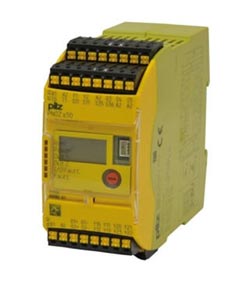Safe controls for safety brakes minimise risks

The ROBA-SBCplus brake control prototype inspected by the TÜV can be deployed up to Performance Level PLe and Safety Integrity Level (SIL) 3.<br>
The “ROBA-SBCplus” brake control, developed together with Pilz, is technically superior in every respect in terms of safety contactor circuits. It offers, among other things, wear-free, electronic switching, it foregoes programming, saves wiring and reduces the construction space requirements. The module prototype-inspected by the TÜV (Technical Inspectorate) can be deployed up to the highest Performance Level PLe and SIL 3.
In order to enable safety brakes to contribute towards risk reduction in machines and systems, they require a reliable control. Vertical axes or stage equipment, for example, rank among the particularly hazardous machine parts. In order to protect people from all hazards in such situations, the remaining functional risks in accordance with safety standard DIN EN ISO 13849-1 must first be assessed, and subsequently suitable measures for the reduction of risks must be taken. As a mechanical component, the brake falls under the category of functional safety in accordance with this standard.
The safety brakes from Mayr power transmission function according to the “fail-safe” principle and are closed in a de-energised state. The brake control has the task of reliably interrupting the current in the magnetic coil when switching the brake off. The brake control module works using wear-free electronic semi-conductors, and therefore achieves practically unlimited switching frequency and switching reliability.
The fail-safe internal construction of the control includes, among other things, the internal diagnostic checks for short circuit, earth short-circuit and line interruptions, as well as reliable overexcitation for releasing the brake and switching to a reduced holding voltage with an open brake. Numerous other safety functions permit a comprehensive error diagnosis: as a result, the output voltage and the switching times for the brake are monitored. The signal evaluation of the release monitoring with plausibility check enables switching condition monitoring of the brake.
Thanks to electronic, wear-free semi-conductor contacts, the ROBA-SBCplus is substantially more reliable and safer than the contactor circuits; and it foregoes complex hardware. The module replaces numerous functional components. Their reduction saves a significant amount of space in the control cabinet due to the reduced wiring and constructional space requirements.
The greatest savings potential is achieved if the performance capability of the module is fully utilised and two brakes are simultaneously reliably controlled. Brakes with a 5 A nominal current can be connected, and the two brakes do not have to be identical in construction. Easy parameterability and the elimination of programming and validation round up the features of superiority.
Contact:
Chr. Mayr GmbH + Co. KG, Eichenstraße 1, 87665 Mauerstetten, Dipl.-Ing. (FH) Hermann Bestle
Tel.: 08341/804-232, Fax: 08341/804-49232
E-Mail: hermann.bestle@mayr.de, Web: http://www.mayr.com
Media Contact
More Information:
http://www.mayr.comAll latest news from the category: Machine Engineering
Machine engineering is one of Germany’s key industries. The importance of this segment has led to the creation of new university degree programs in fields such as production and logistics, process engineering, vehicle/automotive engineering, production engineering and aerospace engineering among others.
innovations-report offers informative reports and articles covering technologies such as automation, motion, power train, energy, conveyor, plastics, lightweight construction, logistics/warehousing, measurement systems, machine tools and control engineering.
Newest articles

Largest magnetic anisotropy of a molecule measured at BESSY II
At the Berlin synchrotron radiation source BESSY II, the largest magnetic anisotropy of a single molecule ever measured experimentally has been determined. The larger this anisotropy is, the better a…

Breaking boundaries: Researchers isolate quantum coherence in classical light systems
LSU quantum researchers uncover hidden quantum behaviors within classical light, which could make quantum technologies robust. Understanding the boundary between classical and quantum physics has long been a central question…

MRI-first strategy for prostate cancer detection proves to be safe
Active monitoring is a sufficiently safe option when prostate MRI findings are negative. There are several strategies for the early detection of prostate cancer. The first step is often a…



